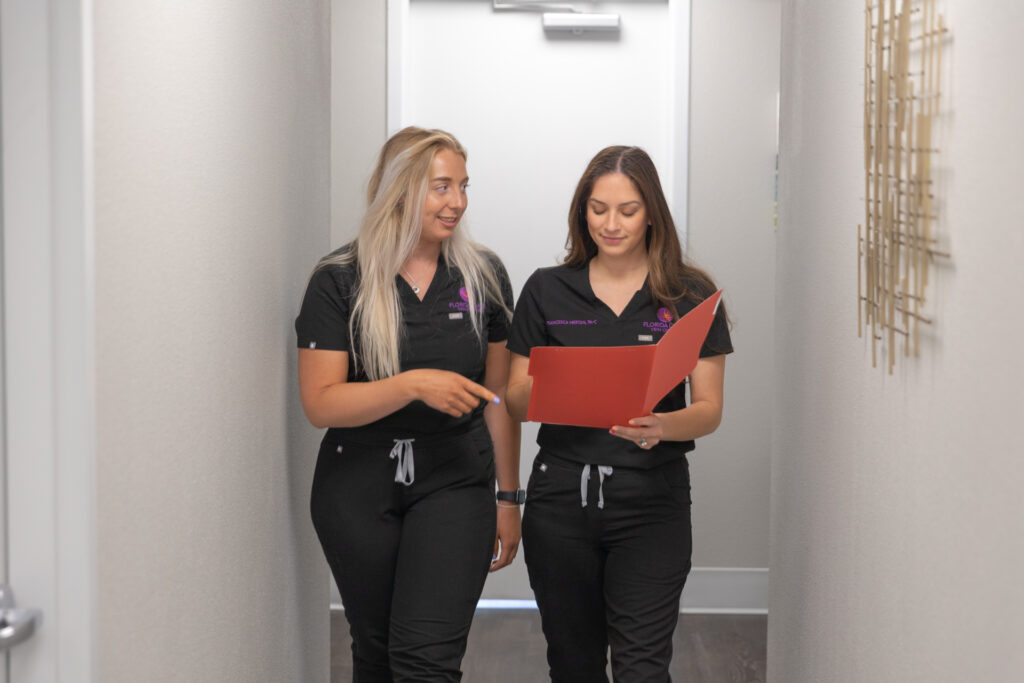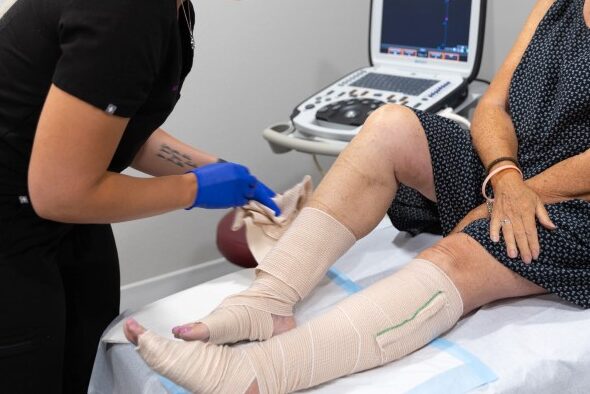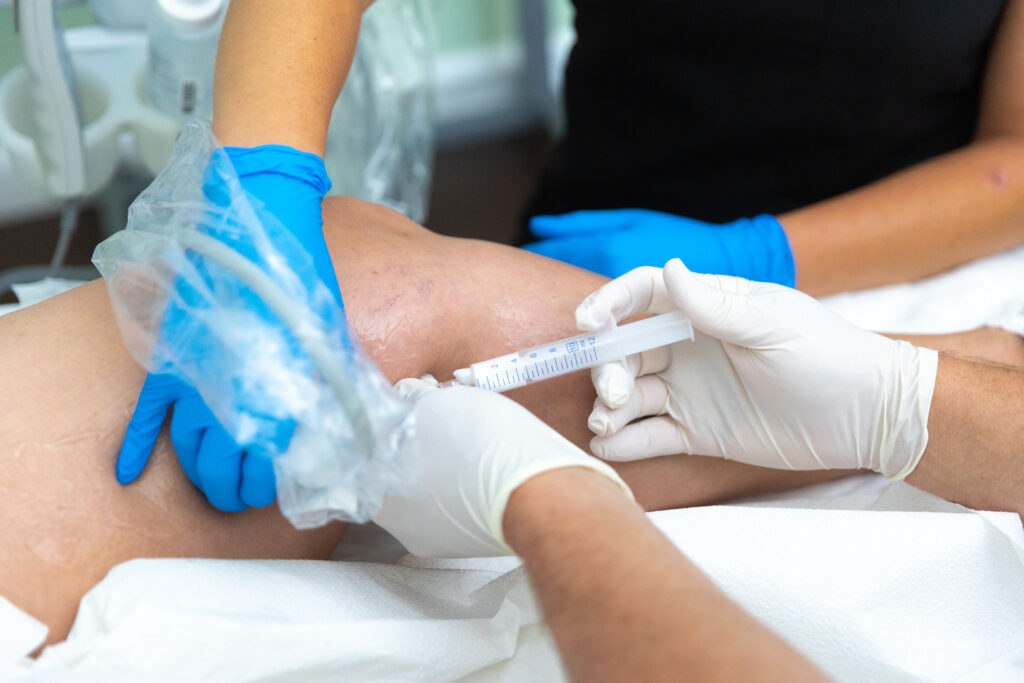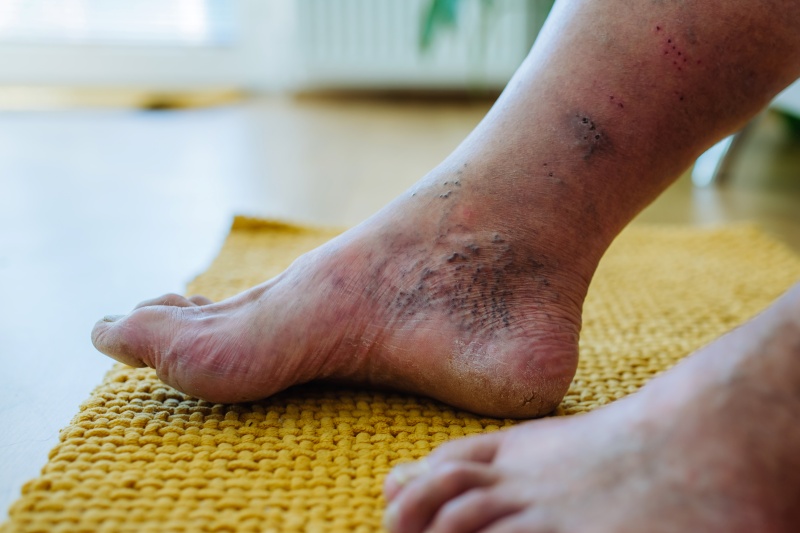
Your veins help your body breathe. They carry oxygenated blood from the lungs to the heart, and from there out to the body. They also transport deoxygenated blood from the body back to the heart, where it circulates back to the lungs to be reoxygenated.
And that’s just the start of how this complex network of vessels moves oxygen, nutrients, infection-fighting cells, and more throughout your body. When something goes wrong in your veins, it can affect your entire system.
That’s why professional and effective vein treatment near Laurel, FL, is so important for your health. At Florida Lakes Vein Center, we make vein care a true “No Veiner®.” Request a screening to understand your vein issues, and read on for a comprehensive guide to how our team of vein care experts can help.
The 1, 2, 3 of DVT
As the 3rd most common vascular disease in the U.S. (2nd only to heart attack and stroke), deep vein thrombosis (DVT) strikes 1 to 3 of every 1,000 adults. DVT and its frequent consequence—pulmonary embolism—is responsible for the deaths of up to 300,000 people each year.
Understanding Deep Vein Thrombosis
DVT occurs when a blood clot forms in a deep vein, typically in the legs. This clot can disrupt blood flow, causing discomfort, swelling, and mobility issues. If the clot dislodges and travels to the lungs, it can result in a life-threatening pulmonary embolism.
Recognizing DVT Symptoms
DVT symptoms are not always obvious, with some patients experiencing no noticeable signs. However, the most common symptoms include:
- Swelling in one leg (rarely both)
- Persistent throbbing or cramping in one leg (rarely both)
- Unusual warmth in the affected area
- Skin discoloration (red or darkened)
- Visible veins that are swollen, firm, or tender to the touch (varicose veins, spider veins)
Without treatment, DVT can lead to complications such as:
- Vein inflammation (phlebitis)
- Venous ulcers
- Pulmonary embolism
Personalized Diagnosis and Treatment
At Florida Lakes Vein Center, we focus on creating individualized treatment plans tailored to each patient’s needs. There is no “cookie-cutter” treatment; rather, we design treatments based on your individual goals, often to achieve any or all of the following:
- Halting clot growth
- Reducing long-term complications like post-thrombotic syndrome
- Preventing future blood clots
- Protecting against pulmonary embolism
Your plan may involve medications, lifestyle changes, or, in severe cases, surgical intervention. Our team of expert vein specialists will guide you through every step, ensuring you understand your choices, how they fit into your lifestyle, and the reasonable expectations for results.

Related topic: Understanding Vein Ultrasound Near Laurel, FL
The DVT Treatment Approach
Your DVT vein treatment near Laurel, FL, generally includes 3 key steps:
- Personalized Consultation: Your specialist will learn about your symptoms, lifestyle, and treatment goals.
- Accurate Diagnosis: Ultrasound technology will assess the veins and surrounding tissue.
- Customized Treatment Plan: We create a personalized strategy to address your unique needs.
Once the treatments, therapy, and/or medications make the DVT either thin out or move to where it no longer poses a threat, we may discontinue treatment. At that point, your provider will have recommendations for at-home health maintenance and future in-office check-ups.
Lymphedema
Lymphedema occurs when the body’s lymphatic system becomes damaged or blocked, preventing proper drainage of lymphatic fluid. This leads to chronic swelling, which can worsen without proper treatment and management.
Though considered a disease, lymphedema isn’t contagious and cannot spread from person to person.
Signs of Lymphedema
At Florida Lakes Vein Center, our specialists assess for common lymphedema symptoms, including:
- Swelling in the arms, legs, fingers, or toes
- Heaviness or tightness in the affected area
- Leg fatigue or pain
- Restricted range of motion
- Recurring infections
- Thickened or hardened skin (fibrosis)
- Skin discoloration or texture changes
- Open sores or blisters that may leak
These symptoms can vary in severity.
Commonly Affected Areas
While lymphedema can occur anywhere on the body, the most commonly affected areas include the:
- Legs
- Arms
- Face
- Neck
- Abdomen
- Genitals
Treatment Options
While lymphedema has no cure, our vein treatment near Laurel, FL, can help you effectively manage the disease. Our team uses advanced vein ultrasound technology to assess the affected area accurately, allowing for precise diagnosis without using invasive methods.
We then tailor treatment to each patient’s specific needs, and may include:
- Lymphatic Massage: Gentle techniques to promote fluid drainage.
- Wound Care: Healing of blisters, ulcers, and sores.
- Education: Guidance on lifestyle changes for better lymphatic health.
- Surgical Alternatives: Recommended only in severe cases.
Because lymphedema symptoms often overlap with vein disease, it’s essential to consult a specialist. Schedule a vein screening and personal consultation to create a customized treatment plan and regain control over your health.
Varicose and Spider Veins
Varicose veins, also known as “varicosities,” can appear as enlarged, twisted veins protruding near the skin’s surface. Similarly, spider veins, or “telangiectasias,” are thin, non-protruding “webs” of visible veins. While neither usually causes major health concerns, they can be a source of discomfort and may indicate an underlying circulatory issue.
Causes of Varicose and Spider Veins
The scientific and medical communities don’t fully understand the exact cause of varicose and spider veins. Several factors have been determined to contribute to their development:
Poor Blood Circulation
Conditions, injuries, or medications that affect blood flow or clotting can lead to the formation of varicose and spider veins.
Damaged Veins
Veins have one-way valves to prevent blood from flowing backward. Damage from surgery, inflammation, infection, or injury can cause these valves to malfunction. When blood pools in these superficial veins, they can stretch, becoming varicose or spider veins.
Treatments for Varicose and Spider Veins
While no treatment can guarantee varicose or spider veins won’t recur, several nonsurgical, minimally invasive options effectively address existing veins.

Varithena
This nonsurgical treatment uses a specialized microfoam, which we inject directly into the affected vein. The Varithena foam collapses the vein, redirecting blood to healthier blood vessels. This improves circulation, reduces discomfort, and minimizes the appearance of varicose veins.
VenaSeal
In the VenaSeal procedure, we inject an advanced medical adhesive into the vein, sealing it shut. Blood naturally reroutes to healthier veins, and the body eventually absorbs the sealed vein.
Sclerotherapy
Sclerotherapy involves the injection of a medical sclerosant into smaller varicose or spider veins. There, the sclerosant irritates the vein lining and causes it to collapse. Blood redirects to healthier veins, and the treated vein fades over time.
Each vein treatment near Laurel, FL, provides excellent results for diminishing—or erasing—the appearance of varicose and spider veins. It’s important to note that though they can make the visible ones disappear, they don’t prevent new varicose or spider veins from forming.
Do varicose and spider veins only affect older patients?
No, varicose and spider veins don’t only occur in more mature adults, although incidence of varicose veins increase with age, up to double by the age of 65. At Florida Lakes Vein Center, we’ve had patients as young as 16 years old.
In younger cases, typical causes of varicose veins include:
- Genetics
- Injury
- Obesity
- Pregnancy
We have also discovered that sometimes younger people who remain on their feet for long stretches, such as hairstylists, develop spider and varicose veins.
Whether a patient is younger or more mature, the Florida Lakes Vein Center team will help determine the underlying causes, so that this can be addressed for a less-likely recurrence in the future.
Related topic: Spider Vein Treatment Near Laurel, FL
Venous Ulcers
Varicose veins significantly increase the risk of venous ulcers, as the bulging skin can be irritated or abraded more readily by clothing. It can also be more easily injured because of its protrusion.

When a wound occurs, the varicose vein also prevents proper blood circulation, thereby slowing the skin’s healing process. Even minor wounds can become infected and develop into chronic ulcers when blood flow is inadequate.
Various factors can cause the pressure that creates varicose ulcers, including:
- Damaged Valves: Failure of vein valves to regulate blood flow properly can cause blood to pool in the lower leg, a condition known as venous insufficiency.
- Varicose Veins: These enlarged, twisted veins result from valve malfunction, disrupting normal circulation.
- Blood Clots: Clots can block veins, reducing blood flow and increasing pressure in the lower leg.
- Obesity: Excess weight places additional pressure on leg veins, worsening circulation.
- Other Conditions: Diabetes, kidney failure, inflammatory diseases, and certain medications can contribute to venous ulcers.
Signs and Symptoms of Venous Ulcers
When any (or all) of the following occur on the legs or ankles, there’s a good chance you’re experiencing a venous ulcer:
- Shallow open sore or wound with a red base
- Uneven, irregular borders around the sore or wound
- Shiny, tight, warm skin surrounding the ulcer
- Discolored skin near the sore
- Discharge around the wound
- Persistent leg pain
A venous ulcer requires prompt medical attention to prevent worsening complications.
A Multi-Tiered Approach to Treatment
The presentation of venous ulcers differs from patient to patient, as does their ability to heal. Our expert team helps manage these sores, wounds, and/or ulcers through diligent wound care.
First, we clean out the wound and use the most innovative, interactive dressings to promote healing. We’ll then teach you home-care for:
- Thorough wound cleaning
- Proper changing of the dressings
- Effective protection of the healthy skin around the ulcer
Compression stockings must be worn every day as you heal. This helps to normalize internal vein pressure to help address the cause of the wound. A venous ultrasound will help us make sure there aren’t further, deeper issues that need attention.
How You Can Support Your Vein Treatment
Near Laurel, FL, your lifestyle greatly affects the success of your vein issue management. Without making supportive efforts at home, plus scheduling check-ups, issues will likely worsen rather than get better.
Any at-home regimen we recommend will be based on your needs and designed to fit into your everyday life. Healthy and therapeutic choices will need to be made, including but not limited to:
- Exercise. We will help you design an exercise program that works for your abilities. Exercise and movement improve both blood flow and drainage.
- Nutrition. We will discuss your diet to target areas that will improve your health and your treatment success.
- Clothing. Certain styles of clothing or other garments and gear can cause or exacerbate issues. We’ll help you weed out the possible issues.
- Compression devices. If a compression device is necessary, we’ll help you understand which ones will work best for your needs.
As your partner in managing your venous health, we’ll help you understand what to do, so you can get back to enjoying life.
Request a Screening and Breathe Easier From Head to Toe
A vein screening helps you understand the cause of your venous issues, and it helps us determine your best vein treatment near Laurel, FL.
Call us if you have questions or just want some advice. Our expert medical team has helped countless people around the area achieve better vein health for happier, more active lives. We would love the opportunity to do the same for you.

About Florida Lakes Vein Center
Florida Lakes Vein Center leads the way in compassionate care and effective, successful vein treatment near Laurel, FL.
Founded by T.C. Lackey II, D.O., a top provider of vein treatment in Florida and a certified Varithena and VenaSeal trainer in Central Florida, our 4 locations have helped over 10,000 patients in the Florida Lakes region improve their mobility, their venous health, and their confidence to live their best life.
At Florida Lakes Vein Center, quality care really is a “No Veiner®.”